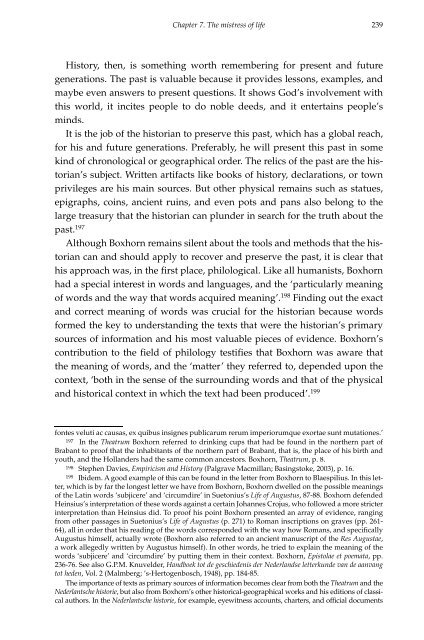historical and political thought in the seventeenth - RePub - Erasmus ...
historical and political thought in the seventeenth - RePub - Erasmus ...
historical and political thought in the seventeenth - RePub - Erasmus ...
Create successful ePaper yourself
Turn your PDF publications into a flip-book with our unique Google optimized e-Paper software.
Chapter 7. The mistress of life<br />
History, <strong>the</strong>n, is someth<strong>in</strong>g worth remember<strong>in</strong>g for present <strong>and</strong> future<br />
generations. The past is valuable because it provides lessons, examples, <strong>and</strong><br />
maybe even answers to present questions. It shows God’s <strong>in</strong>volvement with<br />
this world, it <strong>in</strong>cites people to do noble deeds, <strong>and</strong> it enterta<strong>in</strong>s people’s<br />
m<strong>in</strong>ds.<br />
It is <strong>the</strong> job of <strong>the</strong> historian to preserve this past, which has a global reach,<br />
for his <strong>and</strong> future generations. Preferably, he will present this past <strong>in</strong> some<br />
k<strong>in</strong>d of chronological or geographical order. The relics of <strong>the</strong> past are <strong>the</strong> historian’s<br />
subject. Written artifacts like books of history, declarations, or town<br />
privileges are his ma<strong>in</strong> sources. But o<strong>the</strong>r physical rema<strong>in</strong>s such as statues,<br />
epigraphs, co<strong>in</strong>s, ancient ru<strong>in</strong>s, <strong>and</strong> even pots <strong>and</strong> pans also belong to <strong>the</strong><br />
large treasury that <strong>the</strong> historian can plunder <strong>in</strong> search for <strong>the</strong> truth about <strong>the</strong><br />
past. 197<br />
Although Boxhorn rema<strong>in</strong>s silent about <strong>the</strong> tools <strong>and</strong> methods that <strong>the</strong> historian<br />
can <strong>and</strong> should apply to recover <strong>and</strong> preserve <strong>the</strong> past, it is clear that<br />
his approach was, <strong>in</strong> <strong>the</strong> first place, philological. Like all humanists, Boxhorn<br />
had a special <strong>in</strong>terest <strong>in</strong> words <strong>and</strong> languages, <strong>and</strong> <strong>the</strong> ‘particularly mean<strong>in</strong>g<br />
of words <strong>and</strong> <strong>the</strong> way that words acquired mean<strong>in</strong>g’. 198 F<strong>in</strong>d<strong>in</strong>g out <strong>the</strong> exact<br />
<strong>and</strong> correct mean<strong>in</strong>g of words was crucial for <strong>the</strong> historian because words<br />
formed <strong>the</strong> key to underst<strong>and</strong><strong>in</strong>g <strong>the</strong> texts that were <strong>the</strong> historian’s primary<br />
sources of <strong>in</strong>formation <strong>and</strong> his most valuable pieces of evidence. Boxhorn’s<br />
contribution to <strong>the</strong> field of philology testifies that Boxhorn was aware that<br />
<strong>the</strong> mean<strong>in</strong>g of words, <strong>and</strong> <strong>the</strong> ‘matter’ <strong>the</strong>y referred to, depended upon <strong>the</strong><br />
context, ‘both <strong>in</strong> <strong>the</strong> sense of <strong>the</strong> surround<strong>in</strong>g words <strong>and</strong> that of <strong>the</strong> physical<br />
<strong>and</strong> <strong>historical</strong> context <strong>in</strong> which <strong>the</strong> text had been produced’. 199<br />
fontes veluti ac causas, ex quibus <strong>in</strong>signes publicarum rerum imperiorumque exortae sunt mutationes.’<br />
197 In <strong>the</strong> Theatrum Boxhorn referred to dr<strong>in</strong>k<strong>in</strong>g cups that had be found <strong>in</strong> <strong>the</strong> nor<strong>the</strong>rn part of<br />
Brabant to proof that <strong>the</strong> <strong>in</strong>habitants of <strong>the</strong> nor<strong>the</strong>rn part of Brabant, that is, <strong>the</strong> place of his birth <strong>and</strong><br />
youth, <strong>and</strong> <strong>the</strong> Holl<strong>and</strong>ers had <strong>the</strong> same common ancestors. Boxhorn, Theatrum, p. 8.<br />
198 Stephen Davies, Empiricism <strong>and</strong> History (Palgrave Macmillan; Bas<strong>in</strong>gstoke, 2003), p. 16.<br />
199 Ibidem. A good example of this can be found <strong>in</strong> <strong>the</strong> letter from Boxhorn to Blaespilius. In this letter,<br />
which is by far <strong>the</strong> longest letter we have from Boxhorn, Boxhorn dwelled on <strong>the</strong> possible mean<strong>in</strong>gs<br />
of <strong>the</strong> Lat<strong>in</strong> words ‘subjicere’ <strong>and</strong> ‘circumdire’ <strong>in</strong> Suetonius’s Life of Augustus, 87-88. Boxhorn defended<br />
He<strong>in</strong>sius’s <strong>in</strong>terpretation of <strong>the</strong>se words aga<strong>in</strong>st a certa<strong>in</strong> Johannes Crojus, who followed a more stricter<br />
<strong>in</strong>terpretation than He<strong>in</strong>sius did. To proof his po<strong>in</strong>t Boxhorn presented an array of evidence, rang<strong>in</strong>g<br />
from o<strong>the</strong>r passages <strong>in</strong> Suetonius’s Life of Augustus (p. 271) to Roman <strong>in</strong>scriptions on graves (pp. 261-<br />
64), all <strong>in</strong> order that his read<strong>in</strong>g of <strong>the</strong> words corresponded with <strong>the</strong> way how Romans, <strong>and</strong> specifically<br />
Augustus himself, actually wrote (Boxhorn also referred to an ancient manuscript of <strong>the</strong> Res Augustae,<br />
a work allegedly written by Augustus himself). In o<strong>the</strong>r words, he tried to expla<strong>in</strong> <strong>the</strong> mean<strong>in</strong>g of <strong>the</strong><br />
words ‘subjicere’ <strong>and</strong> ‘circumdire’ by putt<strong>in</strong>g <strong>the</strong>m <strong>in</strong> <strong>the</strong>ir context. Boxhorn, Epistolae et poemata, pp.<br />
236-76. See also G.P.M. Knuvelder, H<strong>and</strong>boek tot de geschiedenis der Nederl<strong>and</strong>se letterkunde van de aanvang<br />
tot heden, Vol. 2 (Malmberg; ’s-Hertogenbosch, 1948), pp. 184-85.<br />
The importance of texts as primary sources of <strong>in</strong>formation becomes clear from both <strong>the</strong> Theatrum <strong>and</strong> <strong>the</strong><br />
Nederlantsche historie, but also from Boxhorn’s o<strong>the</strong>r <strong>historical</strong>-geographical works <strong>and</strong> his editions of classical<br />
authors. In <strong>the</strong> Nederlantsche historie, for example, eyewitness accounts, charters, <strong>and</strong> official documents<br />
239

















